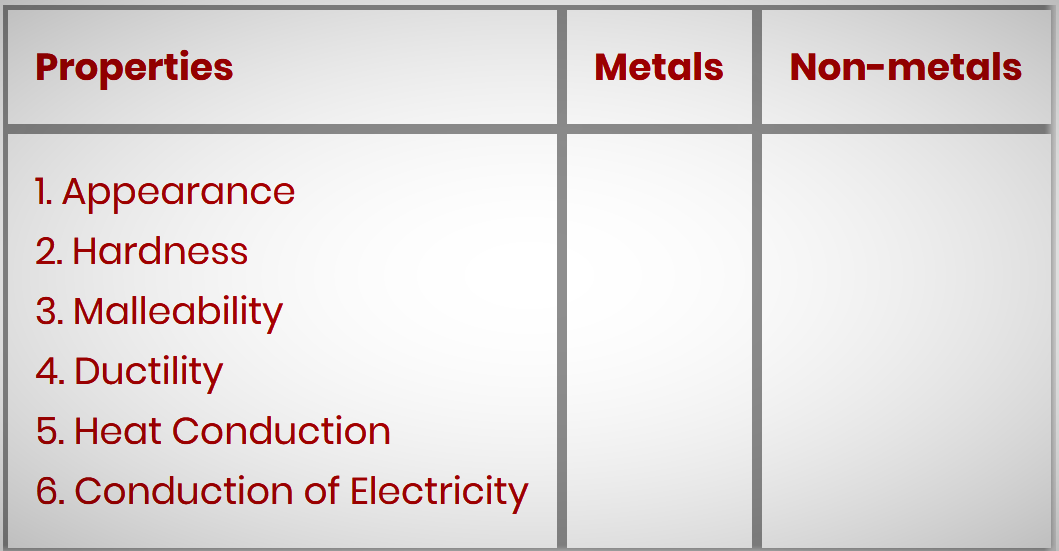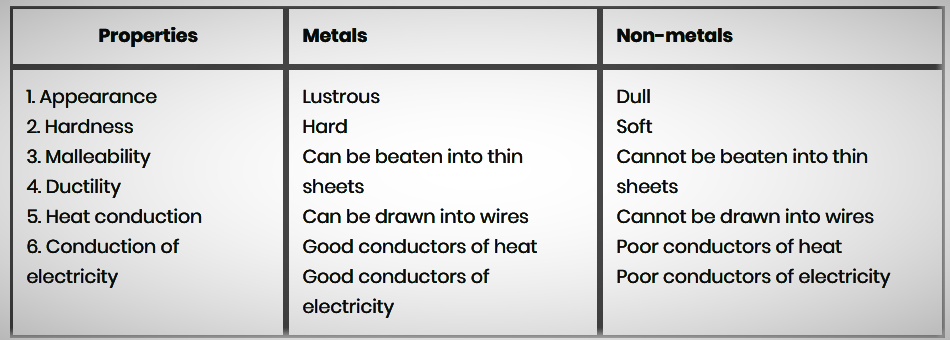GetStudySolution
Getstudysolution is an online educational platform that allows students to access quality educational services and study materials at no cost.
NCERT Solutions for Class 8 Science chapter 4 – Materials-Metals and Non-metals
Back Exercise
Question 1:
Which of the following can be beaten into thin sheets?
(a) Zinc
(b) Phosphorus
(c) Sulphur
(d) Oxygen
Answers
(a) Zinc
Question 2:
Which of the following statements is correct?
(a) All metals are ductile.
(b) All non-metals are ductile.
(c) Generally, metals are ductile.
(d) Some non-metals are ductile.
Answers
(c) Generally, metals are ductile.
Question 3:
Fill in the blanks.
(a) Phosphorus is a very ____________ non-metal.
(b) Metals are ____________ conductors of heat and .
(c) Iron is ____________ reactive than copper.
(d) Metals react with acids to produce ____________ gas.
Answers
(a) reactive.
(b) Good, electricity
(c) more
(d) hydrogen.
Question 4:
Mark ‘T’ if the statement is true and ‘F’ if it is false.
(a) Generally, non-metals react with acids. ( )
(b) Sodium is a very reactive metal. ( )
(c) Copper displaces zinc from zinc sulphate solution. ( )
(d) Coal can be drawn into wires. ( )
Answers
(a) Generally, non-metals react with acids. (F)
(b) Sodium is a very reactive metal. (T)
(c) Copper displaces zinc from zinc sulphate solution. (F)
(d) Coal can be drawn into wires. (F)
Question 5:
Some properties are listed in the following Table. Distinguish between
metals and non-metals on the basis of these properties.

Answers

Question 6:
Give reasons for the following.
(a) Aluminium foils are used to wrap food items.
(b) Immersion rods for heating liquids are made up of metallic substances.
(c) Copper cannot displace zinc from its salt solution.
(d) Sodium and potassium are stored in kerosene.
Answers
(a) Aluminium is a highly malleable metal and can beaten into thin sheets to make foil for wrapping purposes. Also is does not react with food items, that is why aluminium foil is used to wrap food items.
(b) Immersion rods are made up of metallic substances because metals are good conductors of heat and electricity. They get hot very soon on the passage of electric current and warm the water.
(c) The reactivity of zinc is higher than of copper. Only a metal of higher reactivity can displace a metal of lower reactivity from its salt solution. So, copper cannot displace zinc from zinc sulphate solution.
(d) Sodium and potassium are stored in kerosene because they are highly reactive elements. They can easily catch fire even when in contact with air. Therefore they are kept in kerosene.
Question 7:
Can you store lemon pickle in an aluminium utensil? Explain.
Answers
No, we cannot store lemon pickle in an aluminium utensil because aluminium is a metal and metals readily react with acids to produce hydrogen. When aluminium comes in contact with lemon, which is acidic, would react to give hydrogen and the pickles will be spoiled.
Question 8:
Match the substances given in Column A with their uses given in Column B.

Answers

Question 9:
What happens when
(a) Dilute sulphuric acid is poured on a copper plate?
(b) Iron nails are placed in copper sulphate solution?
Write word equations of the reactions involved.
Answers
(a) When dilute sulphuric acid is poured on a copper plate, there will be no reaction between copper and dilute sulphuric acid as copper is less reactive and hence no products will be formed.
(b) Iron being more reactive displaces copper from copper sulphate solution. In this reaction, the blue colour of copper sulphate fades and there is deposition of copper on the iron nail.
Iron (Fe) + Copper Sulphate (CuSO4) → Iron Sulphate (FeSO4) + Copper (Cu)
Question 10:
Saloni took a piece of burning charcoal and collected the gas evolved in a
test tube.
(a) How will she find the nature of the gas ?
(b) Write down word equations of all the reactions taking place in this
process.
Answers
(a) Add a few drops of water in the test tube containing gas. Now, cover the test tube and shake it well. After shaking, test the solution with blue litmus and red litmus. It will turn blue litmus red. Thus, the gas is acidic in nature.
(b) Charcoal reacts with oxygen to form carbon dioxide gas.
C + O2 → CO2
(Carbon from Charcoal) + Oxygen → Carbon Dioxide
Carbon dioxide reacts with water to form carbonic acid, which turns blue litmus paper red.
CO2 + H2O → H2CO3
(Carbon Doixide) + Water → (Carbonic Acid - turns blue litmus red)
Question 11:
One day Reeta went to a jeweller’s shop with her mother. Her mother gave
an old gold jewellery to the goldsmith to polish. Next day when they brought
the jewellery back, they found that there was a slight loss in its weight.
Can you suggest a reason for the loss in weight?
Answers
The gold jewellery is dipped into an acidic solution called aqua regia (a mixture of hydrochloric acid and nitric acid) for polishing. On dipping the gold jewellery in the acid solution, the outer layer of gold dissolves and the inner shiny layer appears. This causes a slight loss in its weight.